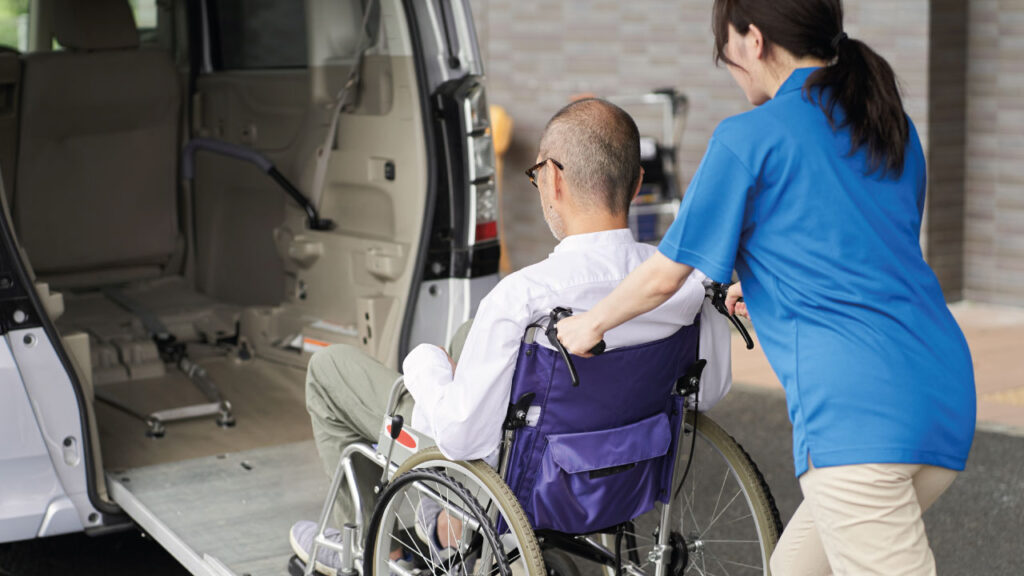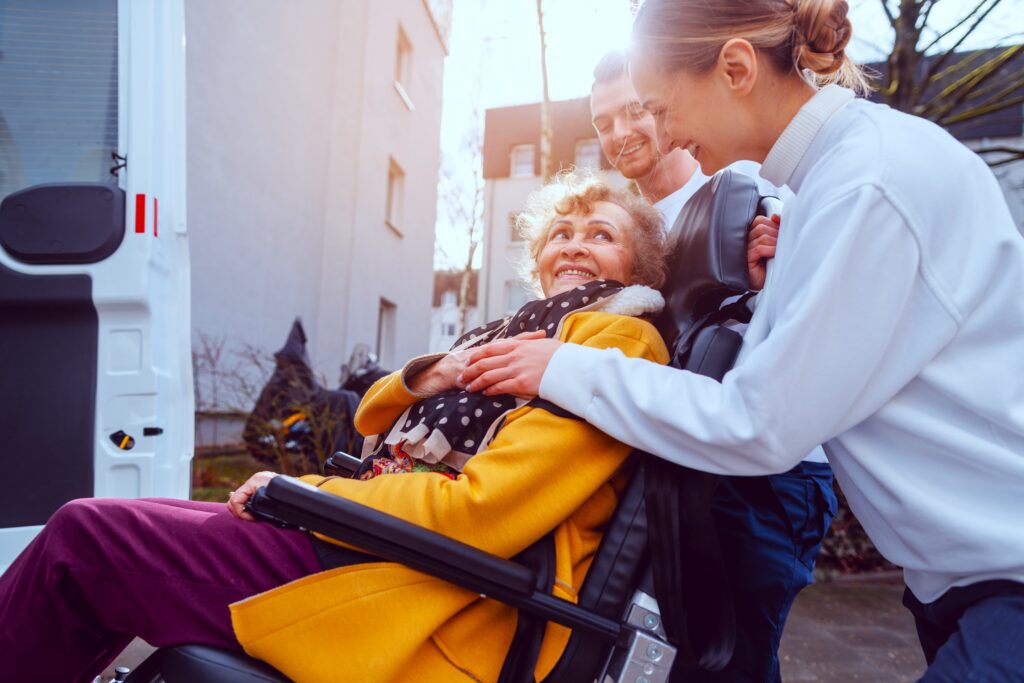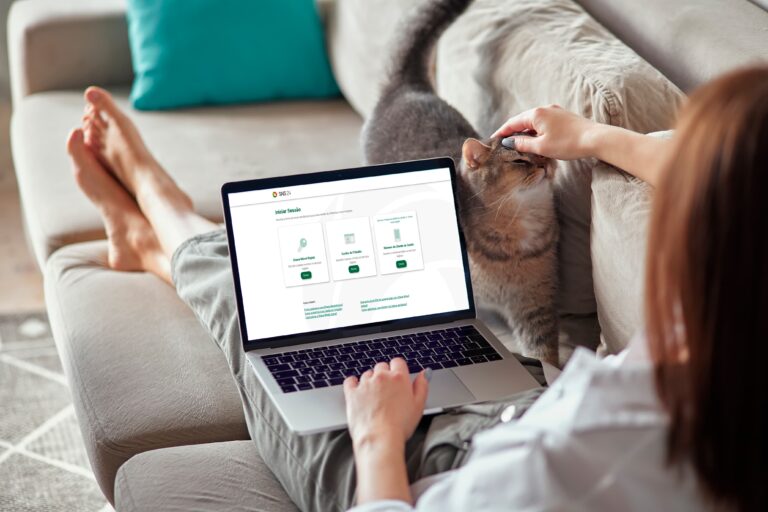Non-emergency patient transportation is a vital part of access to healthcare, ensuring that all users receive the care they need, even if they can’t travel themselves. But how does this service actually work? Who is entitled to it and what options are available?
What is non-emergency patient transportation?
It is a service that ensures the safe movement of patients in specialized vehicles such as ambulances and Dedicated Patient Transport Vehicles (DPTVs), to specific healthcare-related destinations. It is aimed at users who need support to travel to and from healthcare facilities – such as hospitals, health centers and clinics – whether for appointments, regular treatments (such as hemodialysis or physiotherapy) or to return home after a hospital stay.
Unlike emergency transport, which is activated by 112 and requires an immediate response and specialized medical care, non-emergency transport focuses on the comfort and safety of the user, guaranteeing an adequate and peaceful journey, regardless of whether the need is one-off or ongoing.
Types of non-emergency patient transport
This type of transportation can take place in ambulances or dedicated patient transport vehicles (VDTD) and can occur in two main ways:
- Individual transportation: Carried out exclusively for a single patient and intended for cases where it is clinically indicated that the person does not share the vehicle with others
- Multiple transportation: when the health conditions of several users allow, transportation can be shared with other patients who need similar care. Thus, on some routes, it is possible to make stops to pick up other patients, as long as the total journey does not exceed the distance and time limits stipulated by the SNS.
In these situations, small deviations from the initial route are allowed, with a limit of up to 10 km or 30 minutes. Transport timetables are ideally organized to take several users who have appointments or treatments scheduled for the same period.
With Ambula, you have access to different types of transportation, including ambulances for non-emergency individual transportation and vehicles adapted for different mobility needs.
Who is entitled to transportation for non-urgent patients?
In order to benefit from free or reduced-cost transportation, certain specific requirements defined by the SNS must be met. The conditions for exemption from payment are:
- Economically handicapped: patients who can prove that they are economically handicapped may have access to free transportation, provided that they meet one of the following additional conditions:
- Disability of 60% or more
- Need for transportation due to an incapacitating medical condition such as motor sequelae of vascular diseases, heart or respiratory failure, oncological or neuromuscular diseases, high-risk pregnancy, among others.
- Long-term illness: patients with conditions that require continuous and prolonged treatment, such as chronic renal failure (requiring dialysis), long-term motor rehabilitation or palliative care.
- Special situations: people recognized as victims of natural disasters (such as the fires of 2017 and 2018) are also entitled to free transport for treatment.
Note that in order to take advantage of this benefit, the attending doctor, preferably from the SNS, must issue a prescription attesting to the patient’s health condition and the need for transportation.
How is the situation of economic insufficiency determined?
A household is considered to be in a situation of economic insufficiency if the average monthly income, divided by the number of members responsible for supporting the household, does not exceed 763.89 euros. This figure, which can vary annually, corresponds to 1.5 times the value of the Social Support Index (IAS), which in 2024 is 509.26 euros.
In addition, unemployed people registered with the Employment Centre, as well as their spouse and dependents, are also recognized as being in a situation of economic insufficiency.

How do I request transportation for non-emergency patients?
To request this type of transportation, the patient must obtain a medical prescription confirming the need for the service. This prescription can be issued by an NHS doctor and must include a detailed clinical justification. With the prescription in hand, the user can request the transport from the health services or directly contact entities authorized to provide this service, such as the fire department, the Red Cross, associations or specialized companies, such as Ambula .
Can I have a companion during transportation?
Yes, as long as the doctor justifies the need, such as in cases of younger age or profound disability.
What if I'm not entitled to free transportation?
If you are not entitled to free transportation, you can rely on Ambula an intuitive and easy-to-use digital platform for scheduling transportation for non-urgent patients. With the Ambula app, you can quickly schedule the necessary transportation, which can be adjusted to the user’s specific needs, always with a focus on safety, comfort and cost transparency.
Ambula offers several advantages for users:
- Intuitive platform: makes it easy to schedule transportation, simplifying the process for those who need to travel frequently
- Real-time monitoring: allows you to follow the route via geolocation, which gives caregivers and family members peace of mind
- Total transparency: offers clear information on prices and timetables, with no surprises
- Electronic payments: the payment and invoicing process is simple and fast and allows secure electronic transactions
- Guaranteed quality: Ambula works with companies that follow strict quality and ethical standards, ensuring reliable and excellent services.
With these features, Ambula contributes to a safe, modern and humanized transport experience.
How much does it cost to transport non-emergency patients?
For those who are not entitled to free transportation, the cost of the service varies depending on the route, duration and type of transportation required. This may include departure taxes (a flat rate for shorter journeys, which already includes the patient’s round trip), price per kilometer, waiting time and, in some cases, additional costs, such as the use of oxygen or the presence of a companion.
With the Ambula app, we guarantee total transparency: clear information on prices and timetables, with no surprises.




